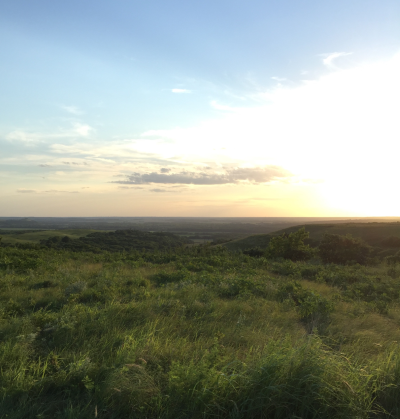Prairie: Why Should We Care?
 While Illinois is officially the “Prairie State”, Kansas has its fair share of grasslands and prairie remnants. Across the state, Kansas has multiple types of grasslands from shortgrass prairies in the west to tallgrass prairies in the east.
While Illinois is officially the “Prairie State”, Kansas has its fair share of grasslands and prairie remnants. Across the state, Kansas has multiple types of grasslands from shortgrass prairies in the west to tallgrass prairies in the east.
Over time, the amount of tallgrass prairie in the east has been declining, with deciduous forest and human development taking its place. Is this such a bad thing?
To answer this, let’s take a closer look at the characteristics of prairies.
Unique Habitat
Tall and shortgrass prairies are home to many different types of plants and animals that are found nowhere else. The grasshopper sparrow, for example, nests on the ground, utilizing the above grass to provide cover. Pollinators, such as native bees and butterflies, rely on certain prairie species for food and shelter.  Many of these pollinators are critical for global food production. Before human eradication, bison grazed on the prairie, living their entire lives in a sea of grass. The amount of diversity really is hard to match within a small section of prairie.
Many of these pollinators are critical for global food production. Before human eradication, bison grazed on the prairie, living their entire lives in a sea of grass. The amount of diversity really is hard to match within a small section of prairie.
Quality Soil
Prairie soils are considered the richest soils on earth. Through a natural process of nutrient recycling that has been going on for millennia, their thick, black topsoil layer is packed full of organic matter making it one of the best soils to grow crops with. This has led to the conversion of most prairies to agricultural crop fields. It’s estimated that less than 4 percent of North America’s prairie remains intact.
Environmental Services
 Prairies provide multiple environmental services that affect our daily lives, including erosion control and water management. Expansive root systems from grasses and forbs weave and tangle together beneath the soil surface, anchoring the soil together. The roots of these plants can grow to impressive depths. Big bluestem, a native tallgrass species, has been observed with roots over twelve feet deep. Large root systems prevent soil from being blown away by the wind or swept away by rainfall. Speaking of rainfall, prairies promote water infiltration into the soil via their deep, spreading roots that act as underground channels. By channeling rainfall into the soil, high water storage levels are achieved, slowing overland waterflow which could potentially lead to flooding.
Prairies provide multiple environmental services that affect our daily lives, including erosion control and water management. Expansive root systems from grasses and forbs weave and tangle together beneath the soil surface, anchoring the soil together. The roots of these plants can grow to impressive depths. Big bluestem, a native tallgrass species, has been observed with roots over twelve feet deep. Large root systems prevent soil from being blown away by the wind or swept away by rainfall. Speaking of rainfall, prairies promote water infiltration into the soil via their deep, spreading roots that act as underground channels. By channeling rainfall into the soil, high water storage levels are achieved, slowing overland waterflow which could potentially lead to flooding.
So, it seems prairies are valuable features on the landscape that deserve our attention and conservation efforts. The question is, how do we conserve prairie. There are multiple strategies already put in place in public land across the country that include prescribed fire*, grazing, and haying. You can use these same strategies on your own property to improve prairie health and fight back against woody encroachment. One key thing to remember is that there is no single picture that captures what a prairie should look like. A healthy prairie is a mosaic of pictures that show strong heterogeneity (differences) throughout time and space. It’s helpful to think of creating a buffet for a group of people with varying diet restrictions. The more variety you provide at your buffet, the more people you can serve.
*Always check local rules and regulations on the use of fire in your area. Permits may be required in some locations.
